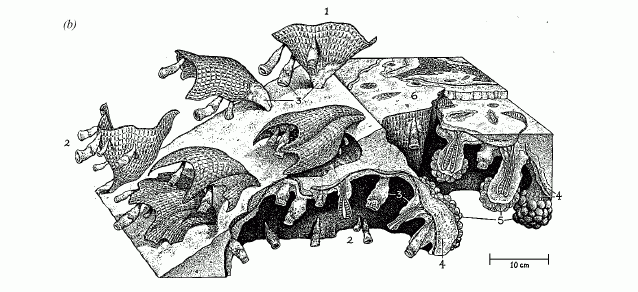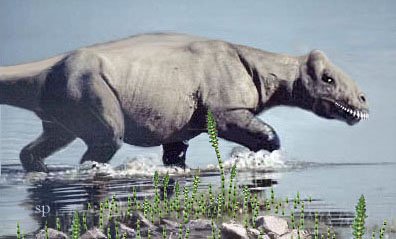The Capitanian Age
The Capitanian Age of the Guadalupian Epoch: 260 to 266 million years ago
Introduction
The Capitanian began on a high note, with a world rich in life in both the sea (with widespread tropical reefs) and on land (with a diverse dinocephalian therapsid fauna). As the age progressed, the climate becaome colder, the sea level fell, and then finally massive volcanos created a sudden greenhouse effect and anoxia. The result was a mass extinction that resulted in a turn-over life on both land and sea.
Stratigraphy
Harried editor's note: As with the Wordian, I am going to be lazy and quote direct from Wikipedia, as this material seems to be well written, and this gives me more time for other pages MAK091116
The Capitanian stage was introduced by George Burr Richardson in 1904. The name comes from the Capitan Reef in the Guadalupe Mountains (Texas, USA). It was first used as a stratigraphic subdivision in 1961, when both names were still only used regionally in the southern US. The stage was added to the internationally used ISC timescale in 2001.
The base of the Capitanian stage is defined as the place in the stratigraphic record where fossils of conodont species Jinogondolella postserrata first appear. The top of the Capitanian is defined by the appearance of the the conodont Clarkina postbitteri postbitteri It includes the ammonite zone Timorites, the conodont biozones Clarkina postbitteri hongshuiensis, Jinogondolella altudaensis, Jinogondolella postserrata and the fusulinid biozones: Rausserella and Afganella schenki
References: Glenister & Furnish 1961, Glenister et al 1991, Gradstein et al 2004
Marine Life
Reefs


Reconstruction of a Permian reef: the Capitan Reef, Texas and New Mexico 260 Ma) (from Wood RA. 1998 Reef Evolution. Oxford: Oxford Univ. Press.).
(a) Platy sponge community. 1. Gigantospongia discoforma (platy sponge); 2: solitary and branching sphinctozoan sponges; 3: Archaeolithoporella (encrusting ?algae); 4: microbial micrite; 5: cement botryoids.
b) Frondose bryozoan-sponge community. 1. Frondose bryozoans (Polypora sp.; Goniopora sp.) 2: solitary sphinctozoan sponges; 3:Archaeolithoporella (encrusting ?algae); 4: microbial micrite; 5: cement botryoids; 6: sediment (grainstone-packstone).
Terrestrial life - Tetrapods
The Capitanian marked the greatest diversity of the Dinocephalian megafauna, and also, in teh middle of teh epoch, its extinction.
According to Bakker, a high large herbivore diversity is indicated by the floodplain facies of the Tapinocephalus Zone of the South African Karroo, where five families or subfamilies and six genera are rather widespread and common; biomass D is about four. This high level of large herbivore diversity was to be also achieved by the radiations of the succeeding therapsid, therapsid-archosaur, dinosaur, and mammal empires. Each dynasty seems to have ended with a mass extinction, and, following a low diversity period, a new ecological community evolves.
As in the preceeding Wordian age, most of the big herbivores and carnivores were Dinocephalians. These may have attained weights of a tonne or more. The only other animals of comparable size were the Pareiasaurs, armoured herbivores specialised for a semi-aquatic existence, and possessing a truely bizarre cranial ornamentation. Accompanying these strange giants were a variety of smaller therapsids, lizard-like anapsids, and rare synapsids and diapsids.

The giant herbivorous dinocephalian Ulemosaurus svijagensis, length 3 meters or more. Late Wordian to Early Capitanian of low latitude northern Pangea. The dinocephalians were the most diverse and successful of the Mid Permian megafauna, f;ourishing for some ten million years, before falling victim to the end-Guadalupian mass extinction
- image from Dinocephalian World (no longer online) |
In the equatorial regions (according to Permian geography - the continents have drifted since then!), the Russian Isheevo Megafauna is probably contemporary with the Early Tapinocephalus Zone (sensu Boonstra), which is the period of greatest Dinocephalian diversity. Here there are two important genera, Doliosauriscus and Ulemosaurus, that appear to be synonymous with (although distinct at the species-level) the Karroo Anteosaurus and Moschops respectively (although it has also been suggestsed that Ulemosaurus may be more basal than Moschops). The more primitive characteristics of the northern fauna, and the preponderance of carnivores over herbivores, may be due to the more equitable climate and to it being more closely tied to water. Curiously, Pareiasaurs are absent from Isheevo; however they appear in the following, Kotelnich assemblage (perhaps equivalent to the Pristerognathus zone), where the epynomous Deltavjatia lends its name to the Deltavjatia vjatkensis Assemblage Zone
Thus at this time one finds both a cool temperate south Gondwanan and a tropical northern Pangean (what is now Russia) dinocephalian-dominated fauna, with a number of very similar large dinocephalians and other animals. These clearly constitute part of the same extended biogeographical region, the fossil remains of which have been found in the vicinity of the Ural mountains. The stratigraphic level is variously referred to as "Zone II" (by Efremov in 1937, and following him by other writers e.g. E.H. Colbert The Age of Reptiles), the Isheevo Deinocephalian Complex (by Tchudinov in the 60s and 70s), and more recently the Ulemosaurus svijagensis zone, and is almost unanimously considered to be contemporary with the Tapinocephalus Zone. So worldwide we see a period of great Dinocephalian diversity.
Indications of the common fauna is indicated by the fact that there are two important genera, the apex preditor Doliosauriscus and the megaherbivore Ulemosaurus, that appear to be congeneric with (although distinct at the species-level) the Karroo Anteosaurus and Moschops respectively, although it has also been suggested that Ulemosaurus may be more basal than Moschops, more like Eodicynodon zone genus Tapinocaninus perhaps, or maybe transitional between the two. Unfortunately, large impressive fossil tetrapod taxa are seriously oversplit by zealous paleontpologists, each of which prefer their own generic name, so that often a genus only has one species (compare this with modern day mammals where a single genus may have a number of species). This obscures the similarities between them. Titanophoneus is another important giant predator, very similar to, but perhaps a little specialised than, Doliosauriscus and Anteosaurus. When full grown these animals had skulls upto 80 cm long, and overall lengths of 3 to 5 meters. Porosteognathus was smaller than these animals, but also evolutionarily more advanced, a medium-sized preditor that may be similar to the South African Pristerognathus. The small brithopidid dinocephalian Syodon is very similar to the Eodicynodon zone genus Australosyodon
Global Cooling
Carbon isotopes in marine limestone from of Capitanian age show an increase in d13C values. The change in carbon isotopes in the sea water indicate severe cooling. This icehouse effect may have caused the end-Capitanian extinction event among species that lived in warm water, like larger fusulinids (Verbeekninidae), large bivalves (Alatoconchidae and Rugosa corals, and Waagenophyllidae. The tropical coral reefs died first, and then fauna from the mid latitudes moved towards the equator.
The cooler temperatures would have also caused massive ice sheets to accumulate, thus causing a fall in sea level. That means less near shore environments and further extinction.
References: Isozakia 2007, link
End-Gaudalupian Extinction
The end of the Capitanian was marked by a marine extinction event distinct from the end Permian mass extinction (Stanley & Yang 1994. There was also a terrestrial mass extinction during the mid Permian (which killed off the dinocephalians and many other large animals), which raises the question of whether they were part of the same event. Lucas 2009a and 2009b considers the terrestrial extinction preceded the Illawara reversal which would make it early to mid Wordian, much earlier than the end-Guadalupian marine extinction. However, Minikh et al 2008 argue that the Kiaman-Illawarra boundary occurs within the Urzhumian stage (dinocephalian fauna), and that the upper Urzhumian can be matched with the upper Capitanian, which indicates that dinocephalians continued throughout at least most of the Capitanian. It still may be the case that the terrestrial and marine extinctions were not necessarily synchronous.
In this current review, I have assumes that dinocephalian extinction event occurred duriong the late or end Capitanian.
The end Capitanian event involved mass extinction, ocean onoxia, sharp isotopic excursions (of Carbon and Strontium, related to vulcanism), sea-level drop, and plume-related volcanism. The remnants of those huge volcanoes can be seen today in India, China and Norway. Retallack 2005 Retallack et al 2006 ties the terrestrial extinction to a greenhouse crisis that he also relates to the end-Guadalupian marine extinction. This is the opposite of Isozakia 2007 and 2009 who refers tpo global cooling. But it may be that first there was a cooling, then a suffered heating, as the temperature fluctuated wildly, further stressing Late Permain environments.
The low diversity Pristerognathus faunal zone would therefore be early Wuchapingian, or at most late Capitanian or early Wuchapingian boundary.
page by
M.Alan Kazlev 2002-2009
page uploaded 20 May 2002, checked ATW050514, last modified MAK091117
(originally uploaded on Kheper Site 28 May 1998)


